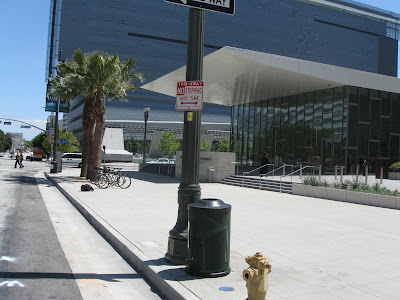It took six months but the Los Angeles Police Department finally added curbside bike parking and sent a clear message to the cycling community that they are welcome at the $500 million headquarters on 1st Street, just across from City Hall. Critics called foul at the ribbon cutting when they discovered that the LAPD bike parking was behind a tower, hidden by planters and trees, behind a wall, all in violation of the basic Crime Prevention Through Environmental Design (CPTED) standards.
The LAPD's failure prompted cyclists to appeal to the Los Angeles Bicycle Advisory Committee (LABAC) who not only called on the City of LA to investigate the absence of appropriate bike parking at the LAPD monument to crime prevention, but the LABAC passed a motion declaring the Ronald F. Deaton Civic Auditorium off-limits for meetings until the situation had been corrected.
All of this was in stark contrast to the stated intentions of then-new LAPD Chief Charlie Beck who declared that one of his first priorities was to forge a strong working relationship with the cycling community and to work on developing policies to better establish, articulate, and enforce policy that protected the rights of cyclists. Unfortunately, when the rubber hits the road, or the bikes hit the racks, cyclists who attended meetings at the LAPD HQ were offered only inhospitable accommodations, even as the LAPD executed stings to catch bike thieves.
For all of the LAPD's good intentions, the simplest way to prevent bike thefts is to properly secure bikes where they are visible, something that wasn't possible at the LAPD HQ. At the last meeting of the Cyclists/LAPD Task Force, cyclists locked their bikes at the top of the courtyard, demonstrating that when it comes to bike security, location matters.
So it is that only six months after the doors opened on the LAPD HQ, the welcome mat finally goes out for the cyclists!
As for the racks, they are the larger "Bike" bike racks, 6' long and in the shape of a bike. They have the same two-bike capacity as the traditional inverted-U rack but with a clear cut message and a tad of flair. We should be pleased and I am. I'm very pleased and I'm encouraged by the message it sends.
At the same time, I think it's fair to evaluate the racks and to seize the opportunity to pursue excellence.
On that note:
1) Bike Racks traditionally run parallel with the curbline, not perpendicular. Granted, the sidewalk here is wide but there is so much real estate, why not establish a standard?
2) First Street is a "No Stopping" zone from Spring to Main so why squeeze the bikes together so tighly, why not spread out?
3) The City of LA had bike parking standards that specify a minimum distance of 48" between parallel racks and yet these four racks have distances of 48", 47", and 43". Why does the City of Los Angeles aim for the minimum requirement and then settle for falling short?

4) The bike racks are out in the open, that is certain, and pedestrians, cyclists and motorists can all see them clearly. This should discourage thieves. Yet the most important eyeline, from the front door of the buildings, is blocked. From the eastside entrance of Deaton Auditorium, none of the racks are visible. From the westside entrance of Deaton Auditorium, two of the racks are visible. From the front door of the LAPD HQ, the racks are obscured to the point that it's unreasonable to expect anyone in the lobby of HQ to notice anything out of the ordinary on the sidewalk in the distance.
Ultimately, it took some time, they might have been installed better, but the effort of the LAPD to respond to the cycling community speaks volumes and it is greatly appreciated.




















